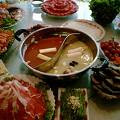 Beginning of the millennium, the image of China to the western world was still farmland and rural people. Now it's the world's second largest economy. In 1999, the per capita income of Chinese urban dwellers was $700 USD - by 2009 that climbed to $2,774.88 USD. It is almost 2010. It seems appropriate to look back China in the past decade.
Beginning of the millennium, the image of China to the western world was still farmland and rural people. Now it's the world's second largest economy. In 1999, the per capita income of Chinese urban dwellers was $700 USD - by 2009 that climbed to $2,774.88 USD. It is almost 2010. It seems appropriate to look back China in the past decade.2001 - China became one of the last major trading nations to join that organization. This event fundamentally redefine China's relations with other countries, especially with the United States, its most significant export market, not to mention its neighbors in the Asian region.
2002 - Entrepreneurs allowed to join the Communist Party. According to old communist ideology, private state owners are considered capitalist pigs and not for the good of the common people. It was the first time in the 81 year history of the party that private entrepreneurs have been selected as provincial congress delegates.
2003 - China became the third nation to independently launch an astronaut into Earth orbit atop its own Long March 2F rocket. The astronaut Yang Liwei who is 5 feet, 6 inches tall came from a family of teachers was being held up to China's population of 1.3 billion as an instant hero.
China also went through a major political change, Hu Jintao replaces Jiang Zemin as president of China.
2004 - The total volume of China's imports and exports exceeded 1 trillion US dollars, making China the world's third largest trading nation after USA and Germany. At the same time, Shanghai overtook Rotterdam as the No 1 port in terms of cargo throughput, handling 382 million metric tons during this year.
2005 - China became the world's fourth-largest economy. It had squeaked by Britain by the tiniest of margins to become the world's fourth-largest economy, according to the World Bank. China produced $2.263825 trillion USD in output in 2005. That was just $94 million USD, or 0.004 percent, more than Britain. The Chinese government also stopped pegging the currency to the U.S. dollar.
2006 - To keep up with 1.3 billion people's energy demand and continue economical expansion within China, the Three Gorges Dam and railway to Tibet were completed. By the end of the year, China's foreign exchange reserves reach $1 trillion, becoming world's largest.
2007 - China surpassed Germany as world's third-largest economy. Its economy expanded by 13 percent to $3.38 trillion. That compared with Germany's 2007 GDP of $3.32 trillion. China was now behind only the United States and Japan. At the same time, the country topped the world with 210 million Internet users.
2008 - This is the year China offically came out to the world. It hosted the Olympics for the first time in a very spetacular matter. With Russia's help China stages its first-ever spacewalk later in the year. However, the year was also very bittersweet. Only 3 months before the Olympics, an 8M deadly earthquake in Sichuan left nearly 90,000 dead or missing. The country also became the world's largest emitter of greenhouse gases.
2009 - China became the world’s second largest economy, passing Japan, which has held this distinction for decades. China’s 2008 GDP was $4.6 trillion and Japan’s was $4.9 trillion. The 2009 numbers are likely to be $4.75 trillion for China and $4.6 trillion for Japan. It will be several decades before China’s GDP can match that of the US. America’s gross domestic product will be over $14 trillion this year. China will gain on that number quickly if US economic output stays below 2% or 3% and China continues to expand at 10% or better.
China's communist party also turned 60 year old this year. 300,000 participants and 60 floats to highlight the country's achievements in various sectors of the society, economy and even military power.





















































